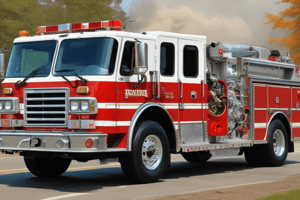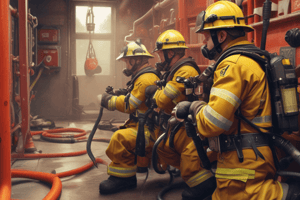Podcast
Questions and Answers
Which mode on the Pump Boss allows the operator to control the pump's output pressure?
Which mode on the Pump Boss allows the operator to control the pump's output pressure?
- Pressure Mode (correct)
- No Water Mode
- RPM Mode
- Low Water Mode
What is the main advantage of using a series water supply?
What is the main advantage of using a series water supply?
- Greater pump longevity
- Higher pump efficiency
- Increased pump reliability
- Ability to maintain continuous water flow (correct)
How are discharge relief valves different from Pump Boss?
How are discharge relief valves different from Pump Boss?
- Pump Boss prevents water hammer
- Pump Boss regulates water flow rate
- Discharge relief valves control pump output pressure
- Discharge relief valves protect against excessive pressure (correct)
What are the three main priorities for drivers/pump operators?
What are the three main priorities for drivers/pump operators?
What is the purpose of intake relief valves?
What is the purpose of intake relief valves?
What does the debate about single-stage vs. two-stage pumps primarily focus on?
What does the debate about single-stage vs. two-stage pumps primarily focus on?
What is the number one goal of any pump operation?
What is the number one goal of any pump operation?
Why is close monitoring of residual intake pressure critical for the safety of crews operating in an IDLH atmosphere?
Why is close monitoring of residual intake pressure critical for the safety of crews operating in an IDLH atmosphere?
What is the purpose of setting up a series water supply according to the text?
What is the purpose of setting up a series water supply according to the text?
What is the role of a known amount of water engine connecting to the water main and beginning operations according to the text?
What is the role of a known amount of water engine connecting to the water main and beginning operations according to the text?
Where was the formula for calculating remaining supply based on the percentage drop obtained from?
Where was the formula for calculating remaining supply based on the percentage drop obtained from?
What is viewed as a safety net by many pump operators according to the text?
What is viewed as a safety net by many pump operators according to the text?
What is the initial pressure considered when water is brought into the pump from one of the intakes?
What is the initial pressure considered when water is brought into the pump from one of the intakes?
What should engine operators note to provide an accurate estimate of available water if the incident escalates and requires more water?
What should engine operators note to provide an accurate estimate of available water if the incident escalates and requires more water?
How is the percentage drop calculated when estimating the remaining flow in the system?
How is the percentage drop calculated when estimating the remaining flow in the system?
In a scenario with a 0-10% drop, how is the remaining supply estimated?
In a scenario with a 0-10% drop, how is the remaining supply estimated?
For an 11-15% drop, how is the remaining supply estimated?
For an 11-15% drop, how is the remaining supply estimated?
What does a 16-20% drop from Static Pressure indicate?
What does a 16-20% drop from Static Pressure indicate?
What does a percentage drop greater than 20% indicate about the remaining water supply?
What does a percentage drop greater than 20% indicate about the remaining water supply?
What should crews do if faced with drops greater than 20%?
What should crews do if faced with drops greater than 20%?
What allows an operator to make an accurate determination of the remaining supply?
What allows an operator to make an accurate determination of the remaining supply?
When is a hydrant supply generally established?
When is a hydrant supply generally established?
What is recommended for engine operators to note for extended lays?
What is recommended for engine operators to note for extended lays?
What should crews do to avoid a sharp drop in Residual Pressure leading to a loss of pressure on interior handlines?
What should crews do to avoid a sharp drop in Residual Pressure leading to a loss of pressure on interior handlines?
What is the primary reason for placing engines in series?
What is the primary reason for placing engines in series?
Why should the supply engine be placed as close as possible to the hydrant?
Why should the supply engine be placed as close as possible to the hydrant?
Why is gating down interior handlines less desirable than gating down exterior lines?
Why is gating down interior handlines less desirable than gating down exterior lines?
When should interior lines be gated down according to the text?
When should interior lines be gated down according to the text?
What is the goal of gating down exterior streams?
What is the goal of gating down exterior streams?
Why is gating down interior lines below their normal operating pressures not recommended?
Why is gating down interior lines below their normal operating pressures not recommended?
What is the main advantage of having attack and supply engines operating in series?
What is the main advantage of having attack and supply engines operating in series?
What should a pump operator do when facing excessive discharge pressure?
What should a pump operator do when facing excessive discharge pressure?
Why is it important for the pump operator to pay attention to residual pressure on the intake gauge?
Why is it important for the pump operator to pay attention to residual pressure on the intake gauge?
In what situation might the Pump Boss believe it is running away from water?
In what situation might the Pump Boss believe it is running away from water?
What is recommended for engine operators to note for extended lays?
What is recommended for engine operators to note for extended lays?
When does a hydrant supply generally get established?
When does a hydrant supply generally get established?
What should crews do if faced with a sharp drop in Residual Pressure leading to a loss of pressure on interior handlines?
What should crews do if faced with a sharp drop in Residual Pressure leading to a loss of pressure on interior handlines?
Why is gating down interior lines below their normal operating pressures not recommended?
Why is gating down interior lines below their normal operating pressures not recommended?
What is the goal of gating down exterior streams?
What is the goal of gating down exterior streams?
What does a 16-20% drop from Static Pressure indicate?
What does a 16-20% drop from Static Pressure indicate?
What does a percentage drop greater than 20% indicate about the remaining water supply?
What does a percentage drop greater than 20% indicate about the remaining water supply?
What is the main advantage of having attack and supply engines operating in series?
What is the main advantage of having attack and supply engines operating in series?
Flashcards are hidden until you start studying



